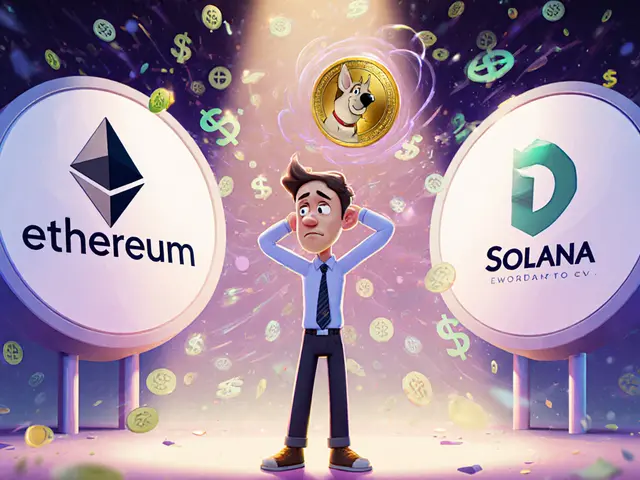FINMA Crypto Licensing Cost & Timeline Calculator
Select your license type and click 'Calculate Estimate' to see your specific costs and timeline.
When you think about launching a crypto exchange in Switzerland, the first hurdle you’ll hit is the FINMA crypto licensing process. FINMA is the Swiss Financial Market Supervisory Authority that oversees all financial services, including cryptocurrency businesses. Its mandate is to protect investors, keep the market stable, and make sure anti‑money‑laundering (AML) rules are followed.
Why FINMA licensing matters for crypto exchanges
Switzerland markets itself as a "Crypto Nation" - home to the famous Crypto Valley in Zug, more than 1,000 blockchain firms, and a reputation for strong investor protection. Without a FINMA license, an exchange can’t open a bank account, can’t advertise to the public, and will face hefty penalties if it processes trades. Licensed exchanges also enjoy easier access to institutional clients; a 2024 PwC survey showed 78 % of FINMA‑licensed platforms attracted new institutional business within a year of approval.
Types of FINMA licenses for exchanges
FINMA doesn’t issue a single generic permit. Instead, it matches the license to the exact activity you plan to perform. Below is a quick rundown of the most common licences:
| License | Core Activities | Min. Capital | Typical Use‑Case |
|---|---|---|---|
| Crypto Exchange License | Facilitates crypto‑fiat & crypto‑crypto trading | CHF 100,000 | Full‑service exchange for retail & institutional traders |
| Crypto Broker License | Acts as an intermediary, no order‑book ownership | CHF 20,000 | Broker‑dealing desks, OTC platforms |
| VASP License | Provides wallet services, transfers, and custodial solutions | CHF 50,000 | Custody‑only providers, payment‑focused apps |
| DLT Trading Venue License | Integrated trading, clearing, settlement & custody of DLT‑securities | CHF 100,000 | Security‑token exchanges, tokenised asset platforms |
Choosing the right licence hinges on whether you’ll hold user funds, match orders in‑house, or only route trades to third‑party markets.
Step‑by‑step process to obtain a FINMA licence
- Incorporate a Swiss legal entity. Most applicants pick an AG (Aktiengesellschaft) with CHF 100,000 share capital or a GmbH (Gesellschaft mit beschränkter Haftung) with CHF 20,000. The incorporation itself takes 3‑4 months.
- Prepare the documentation package. This includes a detailed business plan, financial projections for at least three years, AML/KYC policies, security‑architecture design, and proof of capital.
- Security architecture must feature multi‑signature wallets (3‑of‑5 signing), cold storage for ≥95 % of client assets, and annual penetration testing by a FINMA‑approved auditor.
- Operational resilience must meet a 4‑hour RTO and a 15‑minute RPO for critical systems.
- Submit the application. Upload the package through FINMA’s online portal. Expect a first review within 10 business days, followed by written feedback cycles.
- Address regulator comments. Most applicants spend 1‑2 months clarifying AML procedures, banking relationships, or compliance staffing.
- License approval. Once FINMA signs off, you receive a formal licence letter. The whole pipeline typically spans 4‑8 months from incorporation to go‑live.

Capital, costs and timeline breakdown
Here’s a realistic cost model based on 2024‑2025 case studies:
- Incorporation fees: CHF 4,000‑6,000.
- Government licence fees: CHF 5,000‑15,000 (depends on licence type).
- Consultancy & legal support: CHF 8,000‑15,000 per month during the application phase; most firms hire for 2‑3 months.
- Infrastructure setup (cold storage, multi‑sig wallets, audit): CHF 20,000‑40,000.
- Total estimated outlay: CHF 20,000‑100,000+ before you can start trading.
Timewise, you’ll spend 3‑4 months incorporating, then 1‑4 months navigating regulatory review. Expect an 8‑month horizon if you’re applying for a full Crypto Exchange License; DLT Trading Venue licences have been streamlined to 6‑8 weeks as of the September 2024 update.
Technical and AML compliance requirements
FINMA leans heavily on the Anti‑Money Laundering Act (AMLA) and the Financial Market Infrastructure Act (FMIA). Key obligations include:
- Customer due‑diligence. You must verify identity, source of funds, and politically exposed person (PEP) status for every client.
- Transaction monitoring. Automated systems must flag transactions above CHF 1,000 and report suspicious activity to the Money Laundering Reporting Office (MRO).
- Travel rule compliance. Starting 1 January 2025, you’ll need to share originator and beneficiary details for cross‑border transfers.
- Data retention. Records must be kept for at least five years and be available for FINMA audits.
On the technical side, FINMA’s 2023 guidelines demand:
- Multi‑signature custody wallets with a minimum 3‑of‑5 signing policy.
- Cold storage of at least 95 % of client assets, with periodic penetration tests.
- Business continuity plans that guarantee a max 4‑hour recovery time.

Comparing Swiss licensing to other jurisdictions
Switzerland isn’t the only place offering crypto licences, but it has a distinct mix of pros and cons.
| Jurisdiction | License Speed | Capital Requirement | Regulatory Scope | Key Advantage |
|---|---|---|---|---|
| Switzerland (FINMA) | 4‑8 months (6‑8 weeks for DLT venues) | CHF 100,000 (AG) / CHF 20,000 (GmbH) | Activity‑based, covers securities, custody, trading | Strong institutional credibility, clear licensing pathways |
| EU (MiCA) | 6‑8 weeks (passporting across 27 states) | €125,000‑€300,000 depending on activity | Asset‑based, uniform across EU | Pan‑EU market access |
| Singapore (MAS) | 6‑8 weeks | S$150,000 (≈CHF 130,000) | Payment Services Act, covers VASP & payment wallets | Fast processing, strategic hub for Asia‑Pacific |
If you target European institutional clients, Switzerland still wins on reputation, but MiCA’s passporting can shave months off market entry. Singapore offers speed, yet its regulator is stricter about crypto‑securities, making it less friendly for tokenised equity platforms.
Common pitfalls and pro tips
- Pitfall: Underestimating banking challenges. 62 % of applicants reported difficulty opening a corporate bank account. Tip: Start conversations with Swiss banks early and bring a detailed AML policy.
- Pitfall: Hiring insufficient compliance staff. The average licensed exchange employs 3.2 full‑time compliance officers. Tip: Budget for at least two senior AML specialists from day one.
- Pitfall: Ignoring the substance‑over‑form rule for DeFi protocols. FINMA rejected several decentralised projects in 2024. Tip: If you run a non‑custodial protocol, consider the upcoming DeFi sandbox (Q2 2025) and be ready to demonstrate a professional basis.
- Pitfall: Overlooking technical resilience metrics. Failure to meet the 4‑hour RTO can delay approval. Tip: Conduct a mock disaster‑recovery drill before submission.
What’s next for FINMA and Swiss crypto regulation?
FINMA announced a streamlined DLT Trading Venue procedure in September 2024, cutting approval from four months to under two. A sandbox for non‑custodial DeFi protocols is slated for Q2 2025, with lower capital thresholds and a simplified AML checklist. The revised AMLA, effective 1 January 2025, will enforce the travel rule on high‑value crypto transfers, so platforms must already have interoperable KYC data exchange in place.
In short, Swiss licensing offers a high‑trust environment for serious exchanges, but the process demands capital, compliance expertise, and a solid technical backbone. If you can meet those criteria, the payoff is access to a vibrant institutional market and the “Swiss seal of approval” that many investors still look for.
Do I need a FINMA licence to operate a crypto exchange in Switzerland?
Yes. Any platform that offers trading, custody, or brokerage services for crypto assets must hold a FINMA licence that matches its exact activity. Operating without one can lead to fines, forced shutdown, and loss of banking relationships.
Which licence is right for a pure‑custody service?
A VASP (Virtual Asset Service Provider) licence is designed for custodial wallets, transfers, and AML compliance. It requires a minimum CHF 50,000 capital and a robust KYC/AML framework.
How long does the licensing process usually take?
From company incorporation to licence issuance, most applicants need 4‑8 months. DLT Trading Venue licences have been reduced to 6‑8 weeks for qualifying applications.
Can I use a DeFi protocol without a FINMA licence?
Only if the protocol is truly non‑custodial and does not provide services classified as trading, brokerage, or custody. FINMA’s December 2023 guidance warns that many DeFi projects still fall under the “substance‑over‑form” rule and may need a licence or a sandbox exemption.
What are the main cost drivers for a FINMA licence?
Capital requirements (CHF 100,000 for an AG), government fees (CHF 5,000‑15,000), legal & consulting fees (CHF 8,000‑15,000 per month), and technical setup (cold‑storage, multi‑sig wallets, audits). Total outlay often exceeds CHF 50,000 before launch.




8 Comments
monica thomas
Thank you for the comprehensive overview. The breakdown of licence types makes the selection process clearer. It is evident that capital requirements differ significantly between an AG and a GmbH. The timeline you provided aligns with most project plans I have encountered. I appreciate the inclusion of both cost and technical considerations.
Edwin Davis
From an American perspective, the Swiss regulatory framework feels overly cautious, yet it undeniably offers stability, credibility, and a reputation that many U.S. exchanges still chase, however, the lengthy approval periods and steep capital thresholds can be a deterrent, especially when domestic alternatives are evolving rapidly.
emma bullivant
One might wonder, in the grand scheme of global finance, whether such rigorous oversight truly fosters innovation or merely enshrouds it in bureaucratic veils; perhaps the answer lies not in the statutes but in the collective will of market participants, tho the reality often feels a bit more convoluted.
Michael Hagerman
Wow, reading through the entire licensing guide feels like watching a high‑stakes thriller-each clause a twist, each capital requirement a cliff‑hanger! The part about multi‑signature wallets really had my heart racing, and the deadline tables are like ticking bombs counting down to approval. It’s definitely not a stroll in the park, but for anyone serious about building a solid exchange, it’s the script you need to follow-no shortcuts, no drama‑free moments.
Laura Herrelop
Behind the polished façade of FINMA’s guidelines, one could suspect hidden agendas-perhaps an orchestrated effort to funnel the crypto market into a select few Swiss banks that thrive on secrecy. If the “travel rule” is just a smokescreen, the real goal might be data collection for undisclosed surveillance. Keep an eye out; the layers run deeper than the paper suggests.
Nisha Sharmal
Oh sure, because Swiss banks are notorious for opening doors to any crypto firm-nothing like the legendary “open‑banking” culture of Zürich to make your life easy, right? The reality? Most institutions still treat crypto projects like exotic parasites, demanding endless documentation and caution. Sarcasm aside, be prepared for a marathon of negotiations.
Karla Alcantara
Don’t let those hurdles discourage you; many teams have turned these challenges into opportunities. By engaging banks early and presenting a robust AML framework, you can build trust and pave the way for smoother onboarding. The Swiss ecosystem rewards persistence and transparency.
Jessica Smith
FINMA licences are a waste of time.